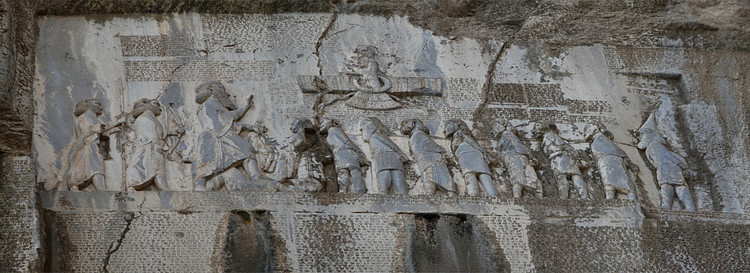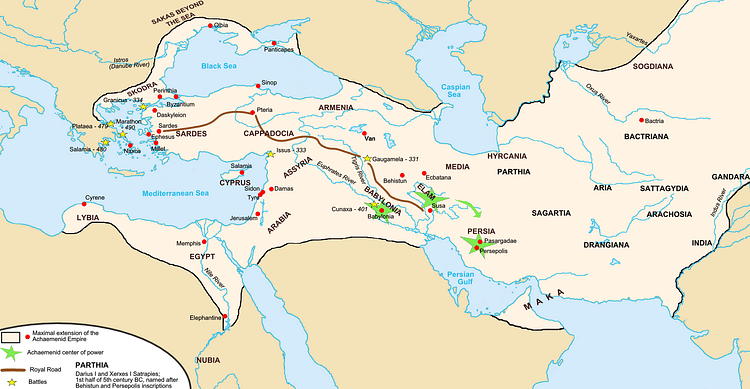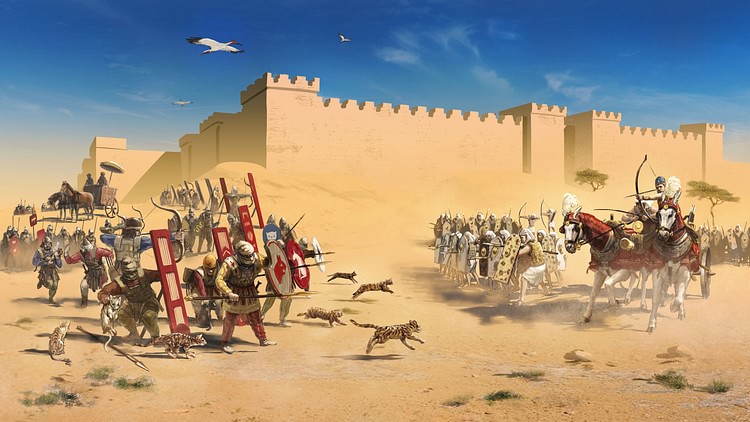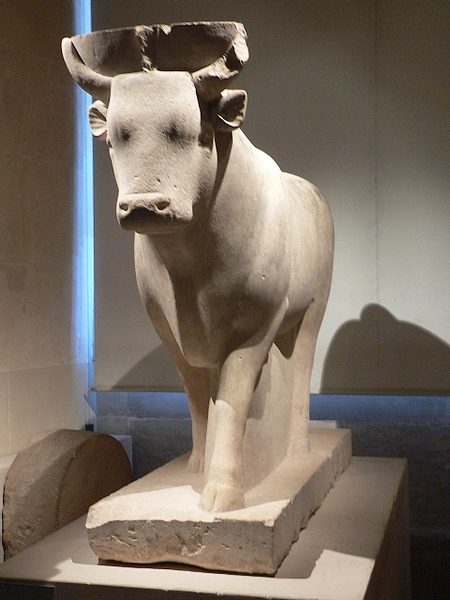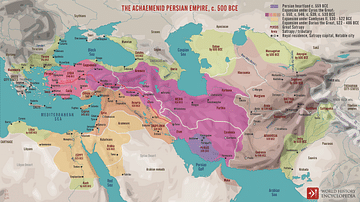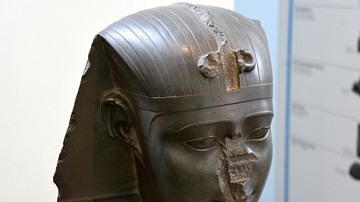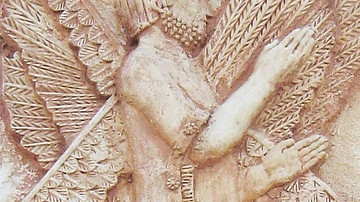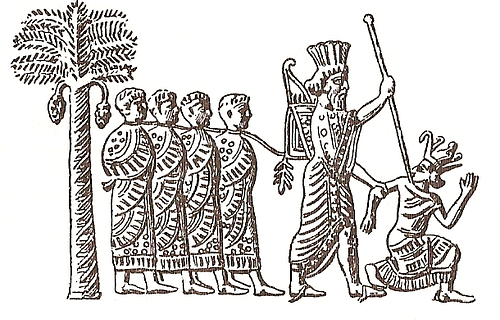
Cambyses II (r. 530-522 BCE) was the second king of the Achaemenid Empire. The Greek historian Herodotus portrays Cambyses as a mad king who committed many acts of sacrilege during his stay in Egypt, including the slaying of the sacred Apis calf. This account, however, appears to have been derived mostly from Egyptian oral tradition and may therefore be biased. Most of the sacrileges attributed to Cambyses are not supported by contemporary sources. At the end of his reign, Cambyses faced a revolt by a man who claimed to be his brother Smerdis, and he died on his way to suppress this revolt.
King of Babylon
Cambyses was born to Cyrus the Great and his wife Cassandane, a sister of the Persian nobleman Otanes. Cambyses had a younger brother named Smerdis, from the same mother and the same father. As early as 539 BCE, when Cyrus conquered Babylon, Cambyses held the position of crown prince. He is mentioned on the Cyrus Cylinder, along with his father Cyrus, as receiving blessings from the Babylonian supreme god Marduk. In Babylonian documents dating between April and December 538 BCE, Cambyses is described as 'king of Babylon', while Cyrus was given the title 'king of the lands'. Cambyses may have been appointed king of Babylon in preparation for his succession to the Persian throne.
Cambyses' reign as king of Babylon was inaugurated by his participation in the Babylonian New Year ceremony on 27 March 538 BCE. The most important function of the Babylonian New Year ceremony was to convey divine legitimization to the ruling monarch. The purpose of this ceremony was to convey divine legitimization to the ruling monarch. The event is described in the Nabonidus Chronicle, but due to the fragmentary nature of the text, it is hard to ascertain what happened. Cambyses is described as wearing Elamite clothing during the occasion and refusing to lay down his arms. This incident may have offended the Babylonian priesthood. It may also have been the reason why his reign as king of Babylon was cut short. After stepping down as king of Babylon, Cambyses remained active in the region, as his name appears in several legal documents from Babylon and Sippar.
Early Reign
Shortly before departing on his campaign against the Massagetae, Cyrus named Cambyses both 'king of the lands' and 'king of Babylon'. When Cyrus died in December 530 BCE, Cambyses succeeded him without any trouble. The early years of Cambyses' reign were relatively uneventful, although a famine in Babylonia between 528 and 526 BCE may have led to rumours that the gods disapproved of the new king.
The Behistun Inscription of Darius the Great states that Cambyses killed his younger brother Smerdis during the early years of his reign:
Afterwards, Cambyses slew this Smerdis. When Cambyses slew Smerdis, it was not known unto the people that Smerdis was slain. Thereupon Cambyses went to Egypt.
The Greek historian Ctesias tells us that Cyrus had appointed Smerdis – known as 'Tanyoxarces' in the work of Ctesias – satrap of the eastern satrapies before his death, a position usually reserved for the crown prince. Since Cambyses had no heir, Smerdis was the next in line of succession. Cambyses may have feared his younger brother's strong position, killing him 'in secret' as the Behistun Inscription states.
Conquest of Egypt
In 525 BCE Cambyses invaded Egypt. Herodotus claims that Pharaoh Amasis II (aka Ahmose II, r. 570-526 BCE) had broken his promise to marry off his own daughter to Cambyses, sending the daughter of the former pharaoh Apries instead. This incident, however, appears to have been merely a pretext for Cambyses to subjugate the last remaining superpower of the region. Amasis himself died in November 526 BCE and was succeeded by his son Psamtik III (r. 526-525 BCE), but this did not stop Cambyses from invading Egypt. The campaign had likely been prepared years in advance.
On his way to Egypt, Cambyses marched his army along the Mediterranean coast. While passing through the Sinai desert, local Arabian chieftains supplied his army with fresh water. Cambyses also sent a Phoenician fleet with reinforcements along the Mediterranean coast. Psamtik sent his admiral Udjahorresnet (aka Wedjahor-Resne) to stop the Phoenician fleet, but Udjahorresnet apparently switched sides before any sea battle could take place. In a similar way, Polycratos of Samos, who had promised to provide Psamtik with mercenaries, decided to send these mercenaries to Cambyses instead. Psamtik was left without allies.
In May 525 BCE Cambyses reached the city of Pelusium, where the easternmost branch of the Nile Delta reaches the Mediterranean Sea. The Persian troops defeated the Egyptians in battle and went on to lay siege to Memphis. After the fall of Memphis, Cambyses continued to march along the Nile, and by August 525 BCE all of Egypt was in Persian hands. The neighbouring Libyan tribes and the Greek city-states along the Libyan coast voluntarily submitted to Cambyses. Upon his conquest of Egypt, Cambyses went to the Egyptian capital of Sais to have himself crowned pharaoh. He took on an Egyptian throne name and took part in Egyptian ceremonies, like his father Cyrus had done upon conquering Babylon. Admiral Udjahorresnet, who had crossed over to the Persians, was appointed chief physician and advisor to Cambyses.
Although Cambyses did not experience much trouble during his initial conquest of Egypt, the fact that he remained stationed there until 522 BCE indicates that he did face some resistance from the local population. At least one rival – Petubastis IV – challenged Cambyses' rule in 522 BCE. Petubastis likely had his residence in the Dakhla Oasis, deep in the Libyan desert. Cambyses may have sent an army to put down this revolt, and this army may have been defeated in battle. This defeat later gave rise to the legend of Cambyses' lost army, known from the work of Herodotus. In order to cover up this loss, the Persians claimed that Cambyses' army was lost in a sandstorm.
MADNESS
While contemporary sources depict Cambyses as a regular king who accommodated to the cultural and religious practices of the lands he conquered, Herodotus portrays him as a stereotypical mad king. Herodotus accuses Cambyses of defiling and burning the corpse of pharaoh Amasis and slaying a newborn Apis calf, who was worshipped as a god in Egyptian religion. In addition, Herodotus interprets Cambyses' murder of his brother Smerdis and his marriage to his sisters Roxane and Atossa as signs of his madness. Such stereotypical portrayals, however, usually arise from subjective oral traditions and should be treated with suspicion. Moreover, there are good reasons to doubt the specific claims pertaining to Cambyses' madness.
First of all, the notion that Cambyses slew a newborn Apis calf is contradicted by contemporary evidence. From funerary steles from the Serapeum of Saqqara, we may infer that one Apis bull died during Cambyses' reign, in September 524 BCE, but this bull was already 20 years old at the time. He was certainly not a newborn calf, as Herodotus claims, and the next Apis bull died during the reign of Darius the Great, at a mature age. Furthermore, the Egyptian priesthood may have had different reasons to hate Cambyses. Cambyses is known to have greatly curbed the privileges that had been bestowed upon the Egyptian temples by the pharaohs of the 26th Dynasty, so the story of Cambyses slaying the Apis bull may well have been invented to further damage Cambyses' reputation.
Another reason to suspect the account of Herodotus is that he places the murder of Smerdis after the invasion of Egypt and also after the slaying of the sacred Apis calf. The more or less contemporary Behistun Inscription, however, clearly states that Cambyses killed Smerdis before he went to Egypt. Herodotus, or his informer, may have taken a certain liberty in describing the order of events in order to make it appear like Cambyses' madness started after he slew the sacred Apis calf. The murder of Smerdis may indeed have been explained as a sign of madness by later Persian kings, but ultimately it was simply a strategic choice on Cambyses' part. Finally, we should not be surprised by Cambyses' marriage to his sisters Roxane and Atossa, as brother-sister marriages had been a common Elamite practice for centuries.
Revolt of (Pseudo-)Smerdis
In March 522 BCE, a man who claimed to be Cambyses' younger brother Smerdis started a rebellion in Persia. Since Cambyses had killed Smerdis 'in secret', most people knew no better than that Smerdis was still alive. The Behistun Inscription describes this event as follows:
Afterwards, there was a certain man, a Magian, Gaumâta by name, who raised a rebellion in Paišiyâuvâdâ, in a mountain called Arakadriš. On the fourteenth day of the month Viyaxana did he rebel. He lied to the people, saying: "I am Smerdis, the son of Cyrus, the brother of Cambyses."; Then were all the people in revolt, and from Cambyses they went over unto him, both Persia and Media, and the other provinces. He seized the kingdom; on the ninth day of the month Garmapada he seized the kingdom.
This narrative has been called into doubt by Albert T. Olmstead, who considers it unlikely that the murder of Smerdis went unnoticed for so many years and that a random imposter so easily took his place. Instead, Olmstead believes that Cambyses never killed Smerdis and that the man who rose up against Cambyses in 522 BCE was, in fact, the real Smerdis. The 'imposter narrative' may have been invented by Cambyses to delegitimize his brother's claim to the throne and was later adopted by Darius the Great to justify his coup against the legitimate successor of Cambyses.
Death
Upon hearing about the revolt, Cambyses immediately gathered his army and prepared to march back home. He confessed to his army that he had killed the real Smerdis 'in secret' years before and claimed that the man who now claimed to be Smerdis was, in fact, an imposter.
Cambyses never met Smerdis in battle. He died in April 522 BCE while he was on his way home. The Behistun Inscription states that Cambyses "died his own death" - a phrasing that has led to much speculation. Herodotus claims that Cambyses died in a Syrian town named Ecbatana after his sword slid out of his scabbard, piercing his thigh at the exact same place where he had stabbed the sacred Apis calf years before. This story seems to be derived from the same oral tradition that attributed Cambyses' madness to the slaying of the Apis bull and is therefore unreliable. Other interpretations are that Cambyses committed suicide or that he was assassinated.
Several places have been identified as Cambyses' tomb, including the Zendan-e Suleiman in Pasargadae and the Takht-e Rustam near Naqsh-e Rustam.
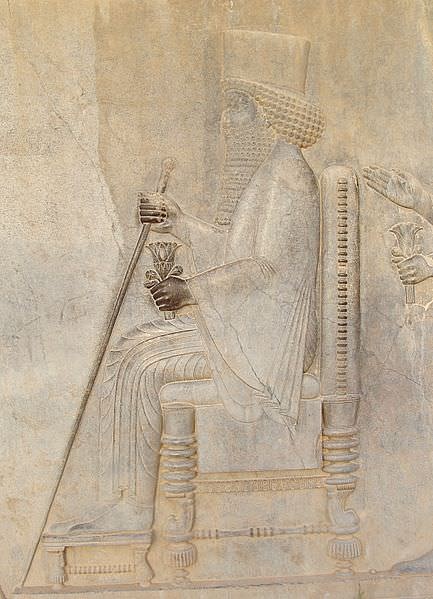
Legacy
Smerdis (either the real one or the imposter Gaumata) continued to rule until September 522 BCE when he was assassinated by seven Persian noblemen. The ringleader of this conspiracy was Darius, who had been a lance-bearer to Cambyses. Now that all male descendants of Cyrus had died, Darius crowned himself king. He claimed to be a distant cousin of Cyrus and stated that the man who claimed to be Smerdis was an imposter. A civil war followed, in which Darius defeated all separatist leaders and reasserted his authority over the empire. With the rise of Darius, a different branch of the Achaemenid Dynasty rose to power. Darius is known for consolidating the early Achaemenid conquests and reorganising the Achaemenid Empire.
As for Cambyses, his reputation quickly deteriorated after his death. The Persians remembered him mostly for his ignoble death, which to them was a sign that Cambyses had lost divine favour. Subsequently, all events from his reign were reinterpreted to fit this narrative. In addition, the Egyptians, who had come to resent Persian rule by the time when Herodotus was writing, had constructed a narrative of Cambyses being a mad king and a blasphemer. Looking at the contemporary evidence, however, Cambyses appears to have been a regular king who continued the policies of his father.
